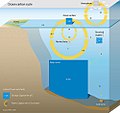The silica cycle is the biogeochemical cycle in which biogenic silica is transported between the Earth's systems. Silicon is considered a bioessential... 37 KB (4,252 words) - 05:20, 15 January 2024 |
 | Diatom (section Silica cycle) cycle, including a higher number of polyamines than most genomes, as well as three distinct silica transport genes. In a phylogenetic study on silica... 148 KB (15,271 words) - 20:14, 11 May 2024 |
 | The water cycle (or hydrologic cycle or hydrological cycle), is a biogeochemical cycle that involves the continuous movement of water on, above and below... 38 KB (4,858 words) - 11:23, 25 April 2024 |
 | The phosphorus cycle is the biogeochemical cycle that involves the movement of phosphorus through the lithosphere, hydrosphere, and biosphere. Unlike... 41 KB (4,508 words) - 23:09, 27 April 2024 |
 | The nitrogen cycle is the biogeochemical cycle by which nitrogen is converted into multiple chemical forms as it circulates among atmospheric, terrestrial... 57 KB (6,199 words) - 23:40, 11 May 2024 |
Reverse weathering (section The silica cycle) weathering on biogenic silica has been of great interest in quantifying the silica cycle. During weathering, dissolved silica is delivered to oceans through... 21 KB (2,534 words) - 02:50, 11 December 2023 |
 | The ozone–oxygen cycle is the process by which ozone is continually regenerated in Earth's stratosphere, converting ultraviolet radiation (UV) into heat... 14 KB (1,795 words) - 19:03, 1 April 2024 |
 | The important sulfur cycle is a biogeochemical cycle in which the sulfur moves between rocks, waterways and living systems. It is important in geology... 59 KB (7,159 words) - 07:33, 8 May 2024 |
 | cycles for the elements calcium, carbon, hydrogen, mercury, nitrogen, oxygen, phosphorus, selenium, and sulfur; molecular cycles for water and silica;... 119 KB (10,775 words) - 12:32, 3 May 2024 |
 | Biogeochemistry (section Biogeochemical cycles) as molecular cycles, such as for water and silica. There are also macroscopic cycles, such as the rock cycle, and human-induced cycles for synthetic... 13 KB (1,427 words) - 00:03, 30 November 2023 |
Methane cycle – Ozone–oxygen cycle – Phosphorus cycle – Selenium cycle – Silica cycle – Supercontinent cycle – Vanadium cycle – Wilson cycle – Zinc cycle Agricultural... 9 KB (629 words) - 01:54, 8 April 2024 |
 | The mercury cycle is a biogeochemical cycle influenced by natural and anthropogenic processes that transform mercury through multiple chemical forms and... 11 KB (1,149 words) - 18:05, 13 April 2024 |
Paul J.; De La Rocha, Christina L. (3 January 2013). "The World Ocean Silica Cycle". Annual Review of Marine Science. 5 (1): 477–501. doi:10... 85 KB (10,618 words) - 11:20, 10 May 2024 |
 | The iron cycle (Fe) is the biogeochemical cycle of iron through the atmosphere, hydrosphere, biosphere and lithosphere. While Fe is highly abundant in... 25 KB (2,818 words) - 03:17, 19 February 2024 |
 | Silicification (section Sources of silica) presence of biogenic silica in various species creates a large-scale marine silica cycle that circulates silica through the ocean. Silica content is therefore... 31 KB (3,436 words) - 12:04, 27 September 2023 |
 | The oceanic carbon cycle (or marine carbon cycle) is composed of processes that exchange carbon between various pools within the ocean as well as between... 57 KB (6,298 words) - 23:38, 4 May 2024 |
 | The boron cycle is the biogeochemical cycle of boron through the atmosphere, lithosphere, biosphere, and hydrosphere. Boron in the atmosphere is derived... 3 KB (272 words) - 16:58, 21 December 2023 |
 | The hydrogen cycle consists of hydrogen exchanges between biotic (living) and abiotic (non-living) sources and sinks of hydrogen-containing compounds... 13 KB (1,387 words) - 14:06, 31 January 2024 |
 | The bromine cycle is a biogeochemical cycle of bromine through the atmosphere, biosphere, and hydrosphere. Bromine is present naturally as bromide salts... 4 KB (391 words) - 10:28, 8 July 2023 |
 | The alkali–silica reaction (ASR), also commonly known as concrete cancer, is a deleterious internal swelling reaction that occurs over time in concrete... 78 KB (9,284 words) - 14:45, 25 March 2024 |
 | The selenium cycle is a biological cycle of selenium similar to the cycles of carbon, nitrogen, and sulfur. Within the cycle, there are organisms which... 5 KB (595 words) - 14:49, 4 August 2023 |







